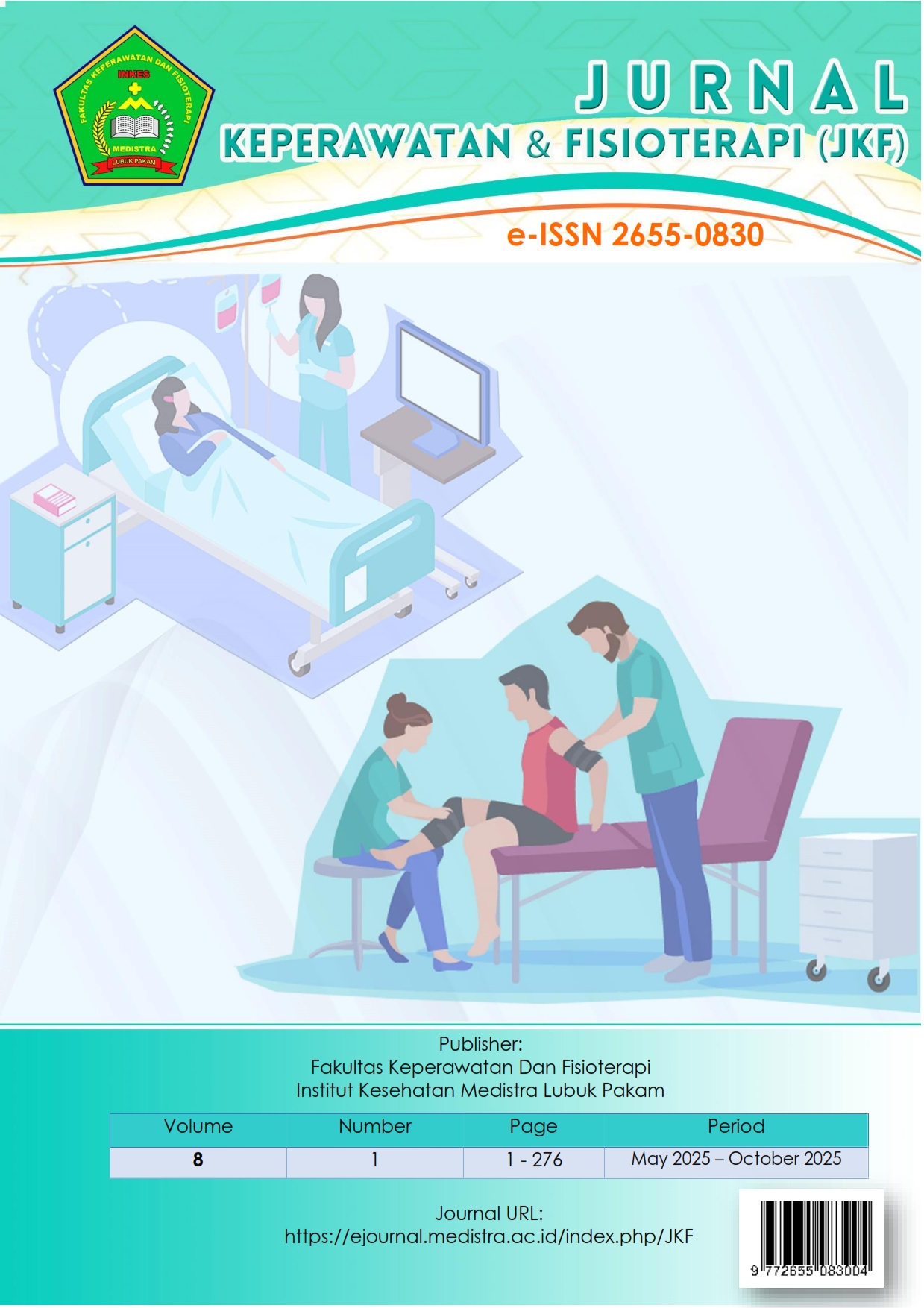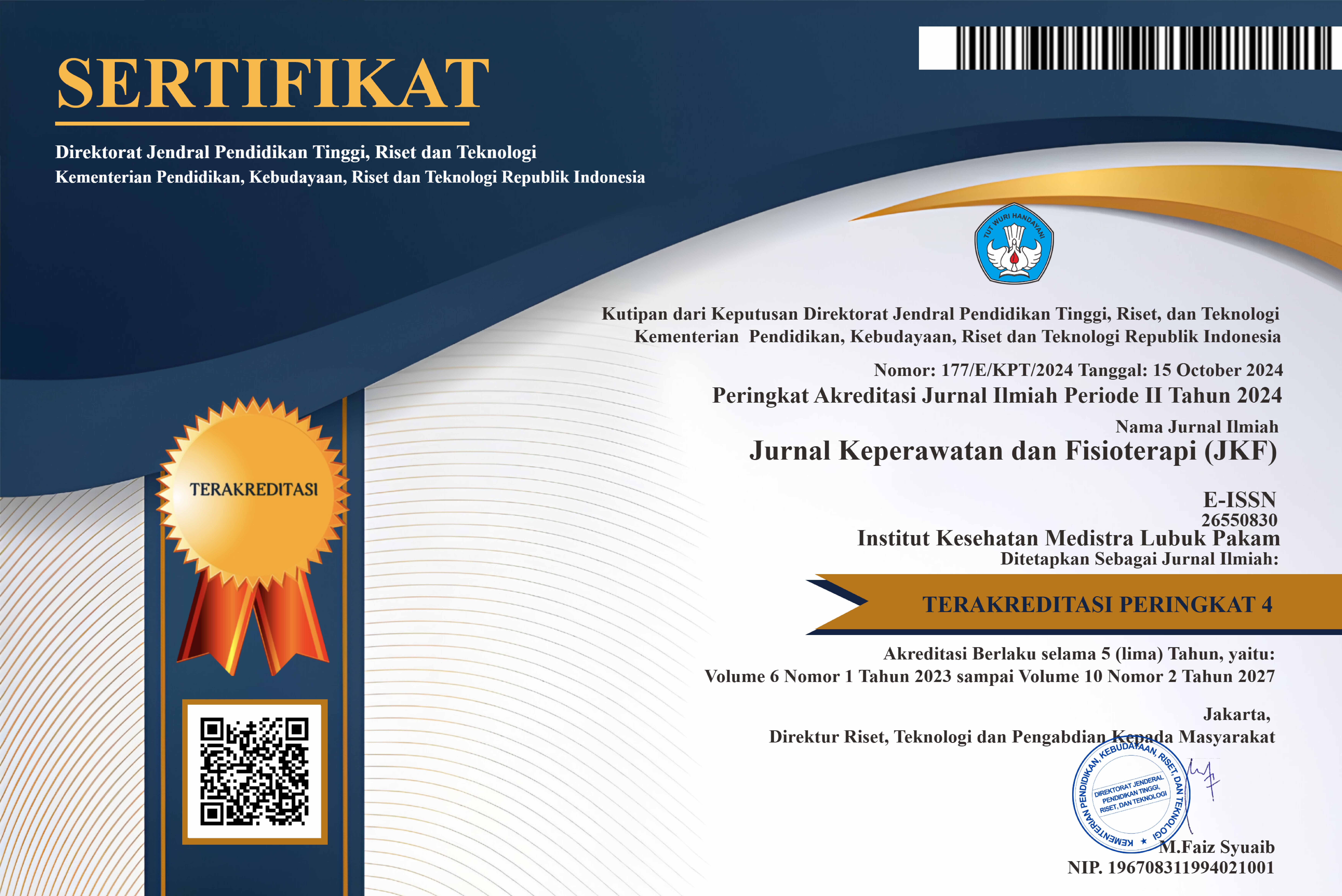Factors Associated With Carpal Tunnel Syndrome (CTS) Complaints in Betel Nut Split and Sort Workers In Cv. Indokara
DOI:
https://doi.org/10.35451/0kbefx47Keywords:
Carpal Tunnel Syndrome, Repetitive Motion, Working Period, Work Posture, AgeAbstract
Background: The work of splitting and sorting areca nuts is done manually with repetitive movements for a long duration. Inappropriate work postures that are not ergonomic and repetitive movements for a long time are one of the risk factors that can trigger Carpal Tunnel Syndrome (CTS). Purpose: This study aims to identify factors that contribute to the emergence of CTS complaints in areca nut splitting and sorting workers at CV. Indokara in 2024. Research methods: This study used an analytical observational design with a quantitative approach and a cross-sectional plan. All workers in the areca nut splitting and sorting section at CV. Indokara became the study population, with a sample size of 38 people obtained through the total sampling technique. Results and discussion: The prevalence rate of CTS complaints found in workers at CV. Indokaraa reached 55.3%. The results of statistical analysis showed that there was a relationship between age (p = 0.031), length of service (p = 0.011), work posture (p = 0.031) and repetitive movements (p = 0.029) with CTS complaints. However, there was no correlation between nutritional status (p = 1,000) and CTS complaints. Conclusion: Age, length of service, work posture, and repetitive movements are related to CTS complaints in areca nut splitting and sorting workers at CV. Indokara in 2024. Therefore, workers are advised to use their break time to stretch their hands regularly. In addition, a policy regarding routine exercise once a week can be implemented and create a posture regarding stretching movements that need to be done by workers.
Downloads
References
[1] S. Putra, F. Handoko, and S. Haryanto, ‘Analisis Beban Kerja Menggunakan Metode Workload Analysis Dalam Penentuan Jumlah Tenaga Kerja Yang Optmal di CV. Jaya Perkasa Teknik, Kota Pasuruan’, Jurnal Valtech (Jurnal Mahasiswa Teknik Industri), vol. 3, no. 2, pp. 82–85, 2020.
[2] D. Purwaningsari, ‘CARPAL TUNNEL SYNDROME (CTS): Literatur Review’, Nov. 2023.
[3] U. Nurullita, R. Wahyudi, and W. Meikawati, ‘Kejadian Carpal Tunnel Syndrome pada Pekerja dengan Gerakan Menekan dan Berulang’, Jurnal Kesehatan Vokasional, vol. 8, no. 1, p. 1, Apr. 2023, doi: 10.22146/jkesvo.69159.
[4] Z. Noor, Buku Ajar Gangguan Muskuloskeletal dan Ergonomi Industri. Jakarta: Salemba Medika, 2023.
[5] L. Romadhona and A. Widodo, ‘Pengaruh Kinesio Taping dan Deep Transverse Friction Terhadap Penurunan Nyeri Kasus Carpal Tunnel Syndrome pada Pekerja Pabrik Rokok’, Journal of Health and Therapy, vol. 2, no. 2, pp. 32–41, 2022.
[6] International Labour Organization, Safe and Healthy Working Environments for All – Introductory Report. Geneva: ILO, 2023. [Online]. Available: https://www.ilo.org/sites/default/files/wcmsp5/groups/public/%40ed_protect/%40protrav/%40safework/documents/publication/wcms_906187.pdf
[7] N. H. I. S. O. H. S. (NHIS-OHS), ‘Carpal Tunnel Syndrome (NHIS 2015) Charts’, Centers for Disease Control and Prevention. Accessed: Nov. 03, 2023. [Online]. Available: https://wwwn.cdc.gov/NIOSH-WHC/chart/ohs-cts?OU=*&T=OU&V=R
[8] U.S. Bureau of Labor Statistics, Employer-Reported Workplace Injuries and Illnesses – 2021–2022. Washington DC: BLS, 2023. [Online]. Available: https://www.bls.gov/news.release/archives/osh_11082023.pdf
[9] Occupational Health Indicators, ‘Tennessee Occupational Health Indicators - 2020 Data Employed Persons, 16 Years and Older’. [Online]. Available: https://www.bing.com/ck/a?!&&p=b73be44d901b1cdeJmltdHM9MTcwMjE2NjQwMCZ pZ3VpZD0yYmY1ZmY2OS1jMWE5LTZkOTYtMDhlNC1mNGIyYzAwYjZjMjUmaW 5zaWQ9NTIxOQ&ptn=3&ver=2&hsh=3&fclid=2bf5ff69-c1a9-6d96-08e4- f4b2c00b6c25&psq=Occupational+Health+Indicators+-+2020+Data&u=a1aHR0cHM6Ly93d3cudG4uZ292L2NvbnRlbnQvZGFtL3RuL2hlYWx 0aC9kb2N1bWVudHMvb2NjdXBhdGlvbmFsLWhlYWx0aC8yMDIwT0hJX1ROLnBkZ g&ntb=1
[10] BPJS Ketenagakerjaan, ‘Data Kecelakaan Kerja dan Penyakit Akibat Kerja di Indonesia Bulan Januari Hingga September 2021’, 2021, BPJS Ketenagakerjaan, Jakarta.
[11] A. Tarwaka, Ergonomi Industri dan Pencegahan Penyakit Kerja. Surakarta: Harapan Press, 2022.
[12] D. Sujadi, ‘Carpal Tunnel Syndrome (CTS) Pada Pekerja Sektor Informal’, Jurnal Penelitian Perawat Profesional, vol. 4, no. 2, pp. 497–504, 2022.
[13] S. Chairunnisa, C. Novianus, and Hidayati, ‘Faktor-Faktor Yang Berhubungan Dengan Gejala Carpal Tunnel Syndrome Pada Komunitas Ojek Online di Kota Tanggerang Selatan Tahun 2021’, Jurnal Fisioterapi dan Kesehatan Indonesia, vol. 1, no. 2, pp. 1–13, 2021.
[14] A. Yudistira et al., ‘Analisis Faktor Risiko Carpal Tunel Syndrome pada Operator Jahit Bagian Produksi PT Leading Garment’, vol. 10, no. 4, 2022, doi: 10.14710/jkm.v10i4.33714.
[15] A. Yudistira, S. Suroto, and S. Jayanti, ‘Analisis Faktor Risiko Carpa Tunnel Syndrome Pad Operator Jahit Bagian Produksi PT Leading Garment’, Jurnal Kesehatan Masyarakat, vol. 10, no. 4, pp. 431–437, 2022.
[16] S. M. H. J. S. Sumitro Adi Putra, ‘Faktor Resiko Carpal Tunnel Syndrome pada Pembuat Pempek Di Kota Palembang’, vol. 11, Apr. 2023.
[17] S. Maharani and W. Trijayanthi Utama, ‘Hubungan Lama Kerja Dengan Kejadian Carpal Tunnel Syndrome (CTS) Pada Pengendara Ojek’, ournal of Language and Health, vol. 5, Aug. 2024, [Online]. Available: http://jurnal.globalhealthsciencegroup.com/index.php/JLH
[18] W. Febriani and M. Hastuty, ‘Faktor-Faktor Yang Berhubungan dengan Kejadian Carpal Tunnel Syndrome (CTS) Pada Pekerja Bagian Produksi di PT Sewangi Sawit Sejahtera Kecamatan Tapung Tahun 2023’, Jurnal Imliah Ilmu Kesehatan, vol. 1, no. 3, pp. 423– 434, 2023.
[19] I. G. W. Pertama, A. F. Rahim, and I. M. Suparsa, ‘Hubungan Postur Kerja Terhadap Keluhan Carpal Tunnel Syndrome Pada Pegawai Administrasi di RSUD Bangli’, ADVANCES in Social Humanities Research, vol. 1, no. 1, pp. 17–27, 2023.
[20] A. P. Pratiwi and T. Diah, ‘FAKTOR - FAKTOR YANG BERHUBUNGAN DENGAN KELUHAN CARPAL TUNNEL’, Jurnal Kesehatan dan Kedokteran, vol. 1, no. 3, pp. 39–45, 2022.
[21] B. Aswin, L. O. Reskiaddin, and Rd. Halim, ‘Hubungan Gerakan Repetitif Dengan Kejadian Carpal Tunnel Syndrome Pada Pekerja Pengemasan Ikan’, Jurnal Ilmu Kesehatan, vol. 11, no. 1, pp. 57–62, 2022.
Downloads
Published
Issue
Section
License
Copyright (c) 2025 Budi Aswin, Nadia Olimvia, La Ode Reskiaddin

This work is licensed under a Creative Commons Attribution 4.0 International License.
Copyright in each article is the property of the Author.


























